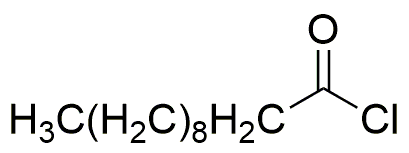Undecanoyl chloride is widely utilized in research focused on:
- Synthesis of Esters: This chemical serves as a key reagent in the production of esters, which are important in the flavor and fragrance industry. For example, it can be used to create fruity scents in perfumes.
- Pharmaceutical Intermediates: It is employed in the synthesis of various pharmaceutical compounds, enhancing drug formulations by providing better solubility and bioavailability.
- Polymer Production: Undecanoyl chloride acts as a building block in the manufacture of polyamides and polyesters, which are essential in textiles and plastics, offering durability and flexibility.
- Surface Modifications: This compound is used for modifying surfaces of materials to improve their hydrophobic properties, making it valuable in coatings and sealants for construction and automotive industries.
- Research in Organic Chemistry: It is a useful reagent in organic synthesis, allowing chemists to explore new pathways for creating complex molecules, thus advancing research in chemical sciences.
General Information
Properties
Safety and Regulations
Applications
Undecanoyl chloride is widely utilized in research focused on:
- Synthesis of Esters: This chemical serves as a key reagent in the production of esters, which are important in the flavor and fragrance industry. For example, it can be used to create fruity scents in perfumes.
- Pharmaceutical Intermediates: It is employed in the synthesis of various pharmaceutical compounds, enhancing drug formulations by providing better solubility and bioavailability.
- Polymer Production: Undecanoyl chloride acts as a building block in the manufacture of polyamides and polyesters, which are essential in textiles and plastics, offering durability and flexibility.
- Surface Modifications: This compound is used for modifying surfaces of materials to improve their hydrophobic properties, making it valuable in coatings and sealants for construction and automotive industries.
- Research in Organic Chemistry: It is a useful reagent in organic synthesis, allowing chemists to explore new pathways for creating complex molecules, thus advancing research in chemical sciences.
Documents
Safety Data Sheets (SDS)
The SDS provides comprehensive safety information on handling, storage, and disposal of the product.
Product Specification (PS)
The PS provides a comprehensive breakdown of the product’s properties, including chemical composition, physical state, purity, and storage requirements. It also details acceptable quality ranges and the product's intended applications.
Certificates of Analysis (COA)
Search for Certificates of Analysis (COA) by entering the products Lot Number. Lot and Batch Numbers can be found on a product’s label following the words ‘Lot’ or ‘Batch’.
*Catalog Number
*Lot Number
Certificates Of Origin (COO)
This COO confirms the country where the product was manufactured, and also details the materials and components used in it and whether it is derived from natural, synthetic, or other specific sources. This certificate may be required for customs, trade, and regulatory compliance.
*Catalog Number
*Lot Number
Safety Data Sheets (SDS)
The SDS provides comprehensive safety information on handling, storage, and disposal of the product.
DownloadProduct Specification (PS)
The PS provides a comprehensive breakdown of the product’s properties, including chemical composition, physical state, purity, and storage requirements. It also details acceptable quality ranges and the product's intended applications.
DownloadCertificates of Analysis (COA)
Search for Certificates of Analysis (COA) by entering the products Lot Number. Lot and Batch Numbers can be found on a product’s label following the words ‘Lot’ or ‘Batch’.
*Catalog Number
*Lot Number
Certificates Of Origin (COO)
This COO confirms the country where the product was manufactured, and also details the materials and components used in it and whether it is derived from natural, synthetic, or other specific sources. This certificate may be required for customs, trade, and regulatory compliance.

